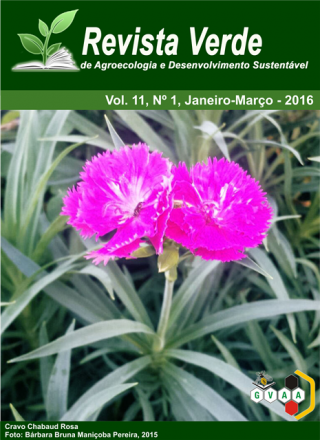CRESCIMENTO INICIAL DA MAMONEIRA SOB DIFERENTES SALINIDADES DA ÁGUA DE IRRIGAÇÃO E DOSES DE NITROGÊNIO
Revista Verde de Agroecologia e Desenvolvimento Sustentável
CRESCIMENTO INICIAL DA MAMONEIRA SOB DIFERENTES SALINIDADES DA ÁGUA DE IRRIGAÇÃO E DOSES DE NITROGÊNIO
Autor Correspondente: Geovani Soares de Lima | [email protected]
Palavras-chave: Ricinus communis L., condutividade elétrica, adubação nitrogenada
Resumos Cadastrados
Resumo Português:
A mamoneira (Ricinus communis L.) é uma planta da famÃlia Euphorbiaceae, que se destaca entre as
oleaginosas pelo elevado valor socioeconômico. Neste sentido, conduziu-se esta pesquisa entre os meses de outubro de
2010 e fevereiro de 2011 objetivando avaliar o crescimento inicial da mamoneira cv. BRS Energia sob diferentes nÃveis
de salinidade da água de irrigação (CEa) e doses de adubação nitrogenada, em experimento conduzido em vasos sob
condições de campo, no CCTA/UFCG. Usou-se o delineamento estatÃstico em blocos casualizados, testando cinco
nÃveis de salinidade da água de irrigação (0,4; 1,4; 2,4; 3,4 e 4,4 dS m-1) e cinco doses de adubação nitrogenada (50, 75,
100, 125 e 150% da dose indicada para ensaio em vaso), em esquema fatorial 5 x 5, com 3 repetições. O número de
folhas, a altura de planta, a fitomassa seca de caule, de folha e da parte aérea da mamoneira cv BRS Energia são
afetados aos 21 DAS, de forma linear e decrescente, pela salinidade da água de irrigação a partir de 0,4 dS m-1; A
salinidade da água de irrigação a partir de 1,0 dS m-1 interfere negativamente no diâmetro caulinar da mamoneira,
independentemente da dose de nitrogênio testada no experimento.Dentre as variáveis estudadas, a fitomassa seca de
folha de mamoneira foi a mais sensÃvel ao estresse salino, ocorrendo redução de 17,5% por aumento unitário da CEa.
Resumo Inglês:
The castor bean (Ricinus communis L.) it is a plant of the family Euphorbiaceae, that stands out among the
oleaginous ones for the high socioeconomic value. In this sense, he behaved this research between the months of
October of 2010 and February of 2011 aiming at to evaluate the initial growth of the castor bean cv. BRS Energy under
different levels of salinity of the irrigation water (ECw) and doses of nitrogenous manuring, in experiment driven in
vases under field conditions, in CCTA/UFCG. the statistical delineation was used in blocks casualizados, testing five
levels of salinity of the irrigation water (0,4; 1,4; 2,4; 3,4 and 4,4 dS m-1) and five doses of nitrogenous manuring (50,
75, 100, 125 and 150% of the suitable dose for rehearsal in vase), in factorial outline 5 x 5, with 3 repetitions. The
number of leaves, the plant height, the biomass dries of stem, of leaf and of the aerial part of the castor bean cv BRS
Energy they are affected to the 21 of the, in a lineal and decreasing way, for the salinity of the irrigation water starting
from 0,4 dS m-1; The salinity of the irrigation water starting from 1,0 dS m-1 interferes negatively in the diameter stem
of the castor bean, independently of the dose of nitrogen tested in experiment. Dentre the studied variables, the, biomass
dries of castor bean leaf was the most sensitive to the saline stress, happening reduction of 17,5% for unitary increase of
ECw.

